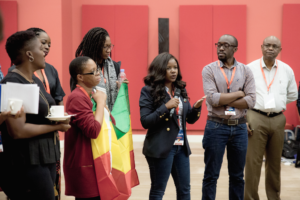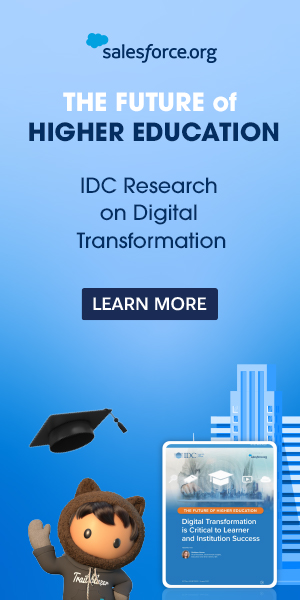
Takeaways from Horizon’s leadership panel on transformation
The Higher Education landscape is ever evolving to meet the needs of students – from re-shaping curriculum to re-designing course delivery methods, all the way to re-modelling student support services – we’ve all witnessed and experienced significant changes over the years. Yet today, we’re moving at a faster pace.
Trends and technology innovation cycles are turning over faster, and the new generation expects everyone to keep up – after all, those who fit into the Gen Z camp, have never known it to be any different. For them, “always on” and always digital is the only norm.
Given the importance of student success for the sector, we hosted a discussion around the topic at our inaugural Higher Ed Summit Horizons conference in October 2018. In a panel session entitled “Re-imagining education in the 21st century”, leaders within the higher education sector shared their views on student success and their perspectives on transformation in higher education.
The panel included Pablo Pajera Alcaraz, Vice Provost at University of Pompeu Fabra, Javier Heitz, CEO of S4G consulting and Marielle Van der Meer, VP of Global affairs at African Leadership University (ALU).
Pablo Langa, Managing Partner at EDT partners moderated the session and set the tone early on by highlighting the top three reasons students pursue a degree in higher education: The Experience, The Future Outcome, and The Passion – provoking, Langa explained that, “in today’s world, students can accomplish these aspirations outside of university, and at a faster pace.”
He then asked the panel, and of course the audience too – “So why higher education then?” and “How are we re-imagining education in the light of today’s world?”
An innovative approach to understanding tomorrow’s students’ needs
Pablo Pajera Alcaraz, Vice Provost at the University of Pompeu Fabra responded by acknowledging that “the struggle to re-imagine education is not a new one.”
He stresses the importance of “finding the balance between re-imagining ourselves (as universities) without losing the essence of who we are”. “Universities shouldn’t limit themselves in delivering exactly what the students want. On the contrary, they should “challenge them, and encourage them to enlarge their aspirations.” Besides the fact that universities are continuously called to transform and stretch themselves, their mission should serve as a set of guiding principles each time the institution envisions a transformation. He recognised that succeeding implies being cognisant not only of the student body, but also of how society is evolving.
For UPF, understanding how to meet today’s (and tomorrow’s) students expectations is delivered by using an innovative approach, which they call Thinkathon. During a Thinkathon, high school students are asked to share what they would like to experience at university in the future, and what a university’s role should be to prepare them for the future.
Industry skills vs Transferable skills
The Higher Education and Research Act (2017) explains that one of the core objectives of universities is to help students progress into employment and for them to benefit from their acquired qualifications over time. However, with the pace of change, it’s not surprising that universities wonder – what are these high-value skills today, and what they will be in the future?
All three panellists agreed that, during university, students should be supported in developing both competences which are in high demand within the industry, and also supported to develop skills that are transferrable across multiple disciplines.
- For Javier Heitz, CEO of S4G consulting, the number one challenge for universities is to teach disciplines that are useful for the job market today. “Today, universities sadly are too disconnecting from the enterprise world.” To illustrate his point, he takes the example of technical skills, like Salesforce, which “very few universities teach” but are very much in demand.
- On the other hand, Marielle Van der Meer, VP of Global affairs at African Leadership University (ALU) reminded everyone that – tomorrow’s students will end up “doing a job that doesn’t exist yet”. And for this reason, universities shouldn’t focus on finding specific skills that are needed today, rather they should think – “how do we prepare students for these jobs”. For Marielle, the logical answer is “equipping them with the skills and the tools that they need to be successful in any job”. That is why the first year curriculum at ALU has been replaced with a programme called the Leadership Core which is focused on helping students “develop the meta-skills needed to thrive throughout their careers.”
- Pajera adds to this by explaining that a university’s “mission goes beyond [the skills gap]”. For him, universities would be doing a very bad job if they limited themselves to responding to the needs of the market. “We have the obligation to not just create a labour force, but also to develop critical individuals who are socially committed.”
Student centred and customer centred
Customer centred or customer first are terms which are widely used across many sectors, and with good reason. Finding your UVP (unique value proposition) today is harder which is why many organisations are choosing to focus on customer needs and deliver services, products and experiences that differentiate them from the competition.
In Higher Education, however, the use of the term customer generates a lot of debate:
- For Van der Meer, both concepts (student and customer) aren’t exclusive: “A university is a place of learning, but it’s also an actual business. Universities need to continue to attract talent to live on. Therefore they must be aware of external forces which push them to tailor their course offering and to reshape their service delivery. When you are in the field of recruiting students, you’re selling a student a choice that will influence the rest of their lives. For these reasons, universities have a “social conscience” to ensure that we’re “selling the right product to the right student” just like any private company will do.
- At UPF, they “see students as students” explained Pajera, but that “doesn’t mean they don’t acknowledge that they need to gain a better understanding of who their students are.” A university’s primary purpose should be to extend and deepen human understanding. Back in 2003, Times Higher Ed was already reflecting on the challenge of higher education to fina d balance between students expectations and universities’ higher purpose.
Future proofing your university with technology
Understanding students, and planning to meet their needs (whether known or not) is obviously a key concern for Higher Education today. And while universities are very aware of the shifting needs, it seems that few succeed to leverage them because they don’t have the infrastructure to support them. Can you imagine how difficult it is to connect with a student in any sort of personalised way, when data about them is scattered across multiple systems that don’t connect with each other?
According to Heitz, universities need to embrace technology to drive change. He believes that – “every university will have a CRM in place in the near future and that CRM is the foundation with which to connect the dots across a university. With a CRM, universities have a 360 degree view of their institution and their students. They can identify at risk students more easily and be more pro-active in their support.”
Pajera adds that “Student success isn’t limited to traditional metrics such as enrolment, retention, persistence. Although important, these practical indicators are just a part of the story. Universities need to measure student happiness, student social contributions and their social impact.” To do this well, and at scale, universities need a robust technology platform, that will also enable them to race to the top.
Download our E-book to find out how can campus-wide CRM help you provide the Connected Campus experience and drive success across the whole student lifecycle.
By Salesforce.org | January 22, 2019 | Digital Transformation, Higher Ed, Leadership | Education, Higher Education, Student Success




























